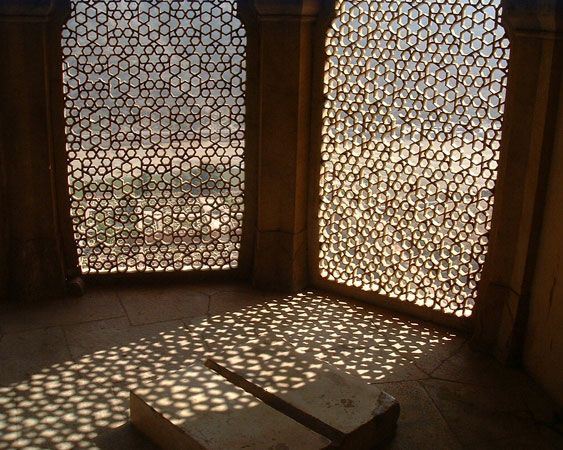A jali or jaali, is the term for a perforated stone or latticed screen, usually with an ornamental pattern constructed through the use of calligraphy and geometry. This form of architectural decoration is common in Hindu temple architecture, Indo-Islamic Architecture and more generally in Islamic Architecture.
Early jali work was built by carving into stone, generally in geometric patterns, while later the Mughals used very finely carved plant-based designs.


Architect Yatin Pandya explains the architectural element of jali well in the following paragraphs, as reported by DNA:
“Jaali as small perforations in a wall has been versatile enough to prove effective in hot dry as well as hot humid climate zones. Jaali manages to cut down on direct sun and thereby the heat ingress. It also allows movement of air for cross breeze and ventilation. Jaali breaks down total square metre of consolidated aperture area of a typical window into number of small holes. The holes are nearly of the same size or often smaller than the thickness of the material it is built with. This means each void is a cubical proportion of height equal to depth, protecting ingress of direct sunrays and haze as well as glare associated with it, for most of the sun angle through the day and across seasons.
It only cuts the glare but lets illumination through, not affecting the intensity of light. Similarly even view across the aperture is maintained. In fact, it makes the view more convenient to Indian notions of privacy. From within, everything outside is visible through Jaali holes but from the outside, nothing gets visible inside due to light difference. This best suited privacy notions and therefore was synonymous to Rajput and Islamic architecture in Middle Ages, the era of defence.
Not only does it work for light, sun and view, it also works scientifically for wind. Both Bernoulli as well as Venturi laws apply effectively through the Jaali. When air passes through smaller aperture, its velocity increases. Thus there is a perceptible presence indoors even with a mild breeze outdoors. This improves efficacy and provides a deeper penetration. Principles of physics also suggest that when air is compressed and released it becomes cool. This is similar to an air-conditioner where compressor, as the name suggests, compresses the air and releases the same through microholes. Thus, Jaali, in micro ways, helps cool the air by passing the same through small holes.
Jaali was an effective element replacing modern day glass for a transparent view and yet improving on the glass by controlling glare and heat and allowing breeze. The proportion of holes was larger and the overall percentage of opacity lower in the humid climates like Kerala and Konkan compared to the drier climes of Rajasthan and Gujarat.
Thus, glamour of glass for uninterrupted view is not a new phenomenon. Jaali achieved the same with better aesthetic grace as well as environment management within socio-cultural denominations of privacy and security. “